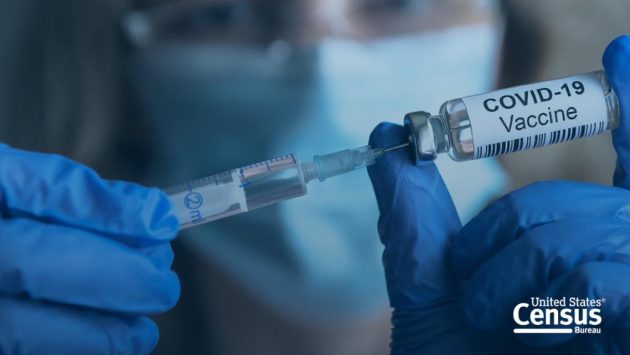
COVID vaccine weekly: support builds for patent waiver as shortages threaten to bite
by Rob Reddick, Commissioning Editor, COVID-19, The Conversation
Various strategies are being pursued to boost worldwide vaccine coverage

A person, wearing gloves and a surgical mask, handles a COVID-19 Vaccine vial and syringe PHOTO: United States Census/ Wikimedia Commons
The US has this week backed a proposal to allow countries to manufacture COVID-19 vaccine doses without needing the agreement of the vaccines’ rights holders. This would be enabled by temporarily waiving intellectual property (IP) protection on all COVID-19 medical products. Removing such protections, the waiver’s proponents argue, will increase the amount of vaccine doses produced globally.
This is the theory. But in practice, waiving IP is unlikely to be a short-term solution to increasing vaccine manufacture, argues Anne Moore, senior lecturer in biochemistry and cell biology at University College Cork. Skills, knowledge and equipment will need to be shared and developed at new sites, which takes time, and material shortages are already limiting production.
Not only that, but IP plays a key role in making sure that vaccines get sufficient industrial backing to be developed in the first place. If protection is waived in the face of a public emergency, even as a one-off, will firms invest next time there is a similar emergency, asks Farasat Bokhari, senior lecturer in economics at the University of East Anglia. Undermining IP could make it harder to respond quickly and effectively to diseases in the future.
In the meantime, Cuba is in a race to make its own COVID-19 vaccine, as explained in the latest episode of The Conversation Weekly podcast. Its efforts are an alternative approach to the same problem identified by those behind the IP waiver, argues Peter Hotez of Baylor College of Medicine in the US – namely, how to avoid low- and middle-income countries being wholly dependent on multinational companies for the vaccines they need.
Cuba has five vaccine candidates in development, two of which have reached phase 3 trials and are being rolled out to thousands of healthcare workers. In the west, widespread distribution of a medical products that haven’t completed testing would be a cause for alarm, but in Cuba, “trust in the government in regards to healthcare has been built up through many, many decades”, explains Jennifer Hosek of Queen’s University, Ontario in Canada.
Certainly, the current situation suggests the world’s vaccine-production capacity needs to be expanded. Much of the world is reliant on Covax, the vaccine-sharing programme, for COVID-19 vaccine doses, with India a key supplier. The risks of relying so heavily on one source are now being realised, writes Rory Horner, senior lecturer at the University of Manchester’s Global Development Institute. Vaccine production in India is struggling, while its second wave means doses intended for export are instead being used for domestic vaccination programmes. The result is that many countries are now short of expected supplies.
Indeed, India’s second wave is still getting worse. New cases have now breached 400,000 a day, with daily deaths close to exceeding 4,000. Yet only around 10% of the population has received a COVID-19 vaccine dose, even despite export doses being redirected internally. It’s time, therefore, for rich nations with good coverage to start donating vaccines to countries, like India, that are clearly in need, says Andrew Pollard, director of the Oxford Vaccine Group. Not only do they have a moral duty to help the vulnerable, but spreading coverage more widely will suppress the virus and return the world to normality more quickly.
This article is republished from The Conversation under a Creative Commons license. Read the original article.